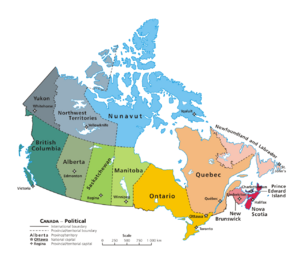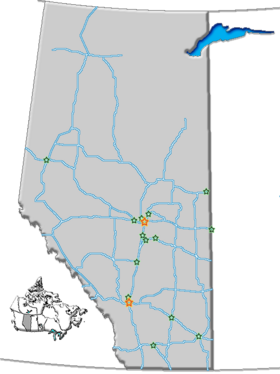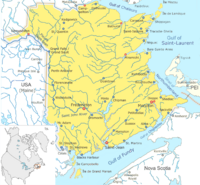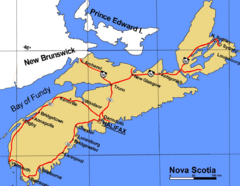List of cities in Canada
This is a list of incorporated cities of Canada in alphabetical order categorized by province. More thorough lists of communities are available for each province.

Contents |
Provincial and territorial capitals
- Alberta: Edmonton
- British Columbia: Victoria
- Manitoba: Winnipeg
- New Brunswick: Fredericton
- Newfoundland and Labrador: St. John's
- Nova Scotia: Halifax
- Ontario: Toronto
- Prince Edward Island: Charlottetown
- Quebec: Quebec City
- Saskatchewan: Regina
- Northwest Territories: Yellowknife
- Nunavut: Iqaluit
- Yukon: Whitehorse
Alberta

To qualify as a city in Alberta, a sufficient population size (over 10,000 people) must be present and a majority of the buildings must be on parcels of land smaller than 1850 square metres.[1] A community is not always incorporated as a city even if it meets these requirements. For example, Fort McMurray merged with Improvement District No. 18 in 1995 to form the Regional Municipality of Wood Buffalo. As a result, it lost its city status and is officially known as a hamlet. Some communities attained city status without reaching the 10,000-population threshold, such as Drumheller (which reverted to town status in 1997). Sherwood Park, despite having ample qualifications to be a city, has chosen to remain, legally, a hamlet.
| City | Area (km²) |
Population (2006) |
Density (/km²) |
Location | Remarks |
|---|---|---|---|---|---|
| Airdrie | 21.48 | 29,035 | 1352 | Part of Calgary Metropolitan Area | |
| Brooks | 17.46 | 11,604 | 664 | ||
| Calgary | 701.79 | 991,759 | 1413 | Largest city in Alberta | |
| Camrose | 25.85 | 15,850 | 613 | ||
| Cold Lake | 59.30 | 11,595 | 196 | ||
| Edmonton | 683.88 | 730,371 | 1042 | Capital of Alberta, second largest city. | |
| Fort Saskatchewan | 45.30 | 14,685 | 324 | Part of Edmonton Capital Region | |
| Grande Prairie | 60.42 | 44,631 | 739 | ||
| Leduc | 36.97 | 15,630 | 423 | Part of Edmonton Capital Region | |
| Lethbridge | 121.83 | 78,713 | 646 | ||
| Lloydminster | 24.19 | 15,487 | 640 | City stretches into Saskatchewan, numbers for Alberta side only | |
| Medicine Hat | 111.99 | 56,048 | 500 | ||
| Red Deer | 60.90 | 82,971 | 1362 | ||
| Spruce Grove | 26.40 | 18,405 | 697 | Part of Edmonton Capital Region | |
| St. Albert | 34.61 | 56,310 | 1627 | Part of Edmonton Capital Region | |
| Wetaskiwin | 15.83 | 11,154 | 705 |
- See also: List of communities in Alberta
British Columbia
In British Columbia, a community can be incorporated as a city if its population exceeds 5,000.[4] Once so incorporated, a city does not lose this status even if its population later declines; the once-thriving city of Greenwood, for example, now has a population of just 695 people.
- See also: List of communities in British Columbia and List of municipalities in British Columbia
| City | Population (2006)[5] | Area (km²) | Location | Remarks |
|---|---|---|---|---|
| Abbotsford | 123,864 | 359.36 | ||
| Armstrong | 4,241 | 5.24 | ||
| Burnaby | 202,799 | 89.12 | Part of Metro Vancouver | |
| Campbell River | 29,572 | 143.48 | ||
| Castlegar | 7,259 | 19.8 | ||
| Chilliwack | 69,217 | 260.19 | ||
| Colwood | 14,687 | 17.76 | Part of Greater Victoria | |
| Coquitlam | 114,565 | 121.69 | Part of Metro Vancouver | |
| Courtenay | 21,940 | 26.68 | ||
| Cranbrook | 18,267 | 25.14 | ||
| Dawson Creek | 10,994 | 22.32 | ||
| Duncan | 4,986 | 2.05 | ||
| Enderby | 2,828 | 4.23 | ||
| Fernie | 4,217 | 16.05 | ||
| Fort St. John | 17,402 | 22.74 | ||
| Grand Forks | 4,036 | 10.44 | ||
| Greenwood | 625 | 2.52 | ||
| Kamloops | 80,376 | 297.3 | ||
| Kelowna | 106,707 | 211.69 | ||
| Kimberley | 6,139 | 58.31 | ||
| Kitimat | 8,987 | 242.63 | ||
| Langford | 22,459 | 39.55 | Part of Greater Victoria | |
| Langley | 23,606 | 10.22 | Part of Metro Vancouver | |
| Merritt | 6,998 | 24.94 | ||
| Nanaimo | 78,692 | 89.3 | ||
| Nelson | 9,258 | 11.72 | ||
| New Westminster | 58,549 | 15.41 | Part of Metro Vancouver | |
| North Vancouver | 45,165 | 11.85 | Part of Metro Vancouver | |
| Parksville | 10,993 | 14.6 | ||
| Penticton | 31,909 | 42.02 | ||
| Pitt Meadows | 15,623 | 85.38 | Part of Metro Vancouver | |
| Port Alberni | 17,548 | 19.92 | ||
| Port Coquitlam | 52,687 | 28.85 | Part of Metro Vancouver | |
| Port Moody | 27,512 | 25.62 | Part of Metro Vancouver | |
| Powell River | 12,957 | 29.77 | ||
| Prince George | 70,981 | 316 | ||
| Prince Rupert | 12,815 | 54.9 | ||
| Quesnel | 9,326 | 35.34 | ||
| Revelstoke | 7,230 | 31.9 | ||
| Richmond | 174,461 | 128.76 | Part of Metro Vancouver | |
| Rossland | 3,278 | 57.97 | ||
| Salmon Arm | 16,012 | 155.36 | ||
| Surrey | 394,976 | 317.19 | Part of Metro Vancouver | |
| Terrace | 11,320 | 41.52 | ||
| Trail | 7,237 | 34.78 | ||
| Vancouver | 578,041 | 114.71 | Largest city, part of Metro Vancouver | |
| Vernon | 35,944 | 94.2 | ||
| Victoria | 78,057 | 19.68 | Provincial capital, Part of Greater Victoria | |
| White Rock | 18,755 | 5.16 | Part of Metro Vancouver | |
| Williams Lake | 10,744 | 33.11 |
Manitoba
| City | Population (2006) | Area (km²) | Location | Remarks |
|---|---|---|---|---|
| Brandon | 41,511 | 465.16 | ||
| Dauphin | 7,906 | 12.65 | ||
| Flin Flon | 5,594 | 11.55 | (partially in Saskatchewan) | |
| Portage la Prairie | 12,728 | 24.67 | ||
| Selkirk | 9,515 | 24.87 | ||
| Steinbach | 11,066 | 25.57 | ||
| Thompson | 13,446 | 17.18 | ||
| Winkler | 9,106 | 17.02 | ||
| Winnipeg | 633,451 | 464.01 | provincial capital/largest city |
New Brunswick

- See also: List of communities in New Brunswick
| City | Population (2006) | Area (km²) | Location | Remarks |
|---|---|---|---|---|
| Bathurst | ||||
| Campbellton | ||||
| Dieppe | ||||
| Edmundston | ||||
| Fredericton | Provincial capital | |||
| Miramichi | ||||
| Moncton | Largest metropolitan area | |||
| Saint John | Largest city |
Newfoundland and Labrador
- See also: List of communities in Newfoundland and Labrador
- Corner Brook
- Mount Pearl
- St. John's - provincial capital/largest city
Northwest Territories
As in the other two Canadian territories, the only incorporated city in the Northwest Territories is its capital, Yellowknife.
- See also: List of communities in the Northwest Territories
- Yellowknife - territorial capital
Nova Scotia

Nova Scotia no longer has any incorporated cities, as they were amalgamated into Regional Municipalities in the 1990s.
- See also: List of communities in Nova Scotia
- Halifax - provincial capital and Metropolitan Area, now part of the Halifax Regional Municipality
- Sydney - former city, now part of the Cape Breton Regional Municipality
- Dartmouth - formerly the second largest city in Nova Scotia, now a Metropolitan Area and part of the Halifax Regional Municipality.
As in the other two Canadian territories, the only incorporated city in Nunavut is its capital, Iqaluit.
- See also: List of communities in Nunavut
- Iqaluit - territorial capital
Ontario
In Ontario, city status is conferred by the provincial government, generally upon the request of the incorporated municipality. A municipality may apply for city status anytime after its population surpasses 10,000. This status is not automatically conferred on a community that reaches this population target, but must be requested by the municipality and granted by the provincial Ministry of Municipal Affairs and Housing. Not all municipalities which reach this population target have pursued city designation (as, for example, Markham, Ajax and Oakville). Once designated a city, however, a municipality does not lose this status even if its population later falls back below 10,000 (as, for example, Dryden.)
City status may also be conferred on some rural counties which have been amalgamated such that all municipal governance takes place at the county level with no further municipal subdivisions. Thus, city status in Ontario does not always connote a primarily urbanized community.
- See also: List of communities in Ontario
| City | Census division | Population 2006[6] |
Location |
| Barrie | Simcoe County | 128,430 | |
| Belleville | Hastings County | 48,821 | |
| Brampton | Peel Region | 433,806 | |
| Brant | Brant | 34,415 | |
| Brantford | Brant | 90,192 | |
| Brockville | Leeds and Grenville | 21,957 | |
| Burlington | Halton Region | 164,415 | |
| Cambridge | Waterloo Region | 120,371 | |
| Chatham-Kent | single-tier | 108,177 | |
| Clarence-Rockland | Prescott and Russell | 20,790 | |
| Cornwall | Stormont, Dundas and Glengarry | 45,965 | |
| Dryden | Kenora District | 8,195 | |
| Elliot Lake | Algoma District | 11,549 | |
| Greater Sudbury | single-tier | 157,857 | |
| Guelph | Wellington County | 114,943 | |
| Haldimand County | single-tier | 45,212 | |
| Hamilton | single-tier | 504,559 | |
| Kawartha Lakes | single-tier | 74,561 | |
| Kenora | Kenora District | 15,177 | |
| Kingston | Frontenac County | 117,207 | |
| Kitchener | Waterloo Region | 204,668 | |
| Lambton Shores | Lambton County | 11,150 | |
| London | Middlesex County | 352,395 | |
| Mississauga | Peel Region | 668,549 | |
| Niagara Falls | Niagara Region | 82,184 | |
| Norfolk County | single-tier | 60,847 | |
| North Bay | Nipissing District | 53,966 | |
| Orillia | Simcoe County | 30,259 | |
| Oshawa | Durham Region | 141,590 | |
| Ottawa | single-tier | 812,129 | |
| Owen Sound | Grey County | 21,753 | |
| Pembroke | Renfrew County | 13,930 | |
| Peterborough | Peterborough County | 74,898 | |
| Pickering | Durham Region | 87,838 | |
| Prince Edward County | single-tier | 25,496 | |
| Port Colborne | Niagara Region | 18,599 | |
| Quinte West | Hastings County | 42,697 | |
| Sarnia | Lambton County | 71,419 | |
| Sault Ste. Marie | Algoma District | 74,948 | |
| St. Catharines | Niagara Region | 131,989 | |
| St. Thomas | Elgin County | 36,110 | |
| Stratford | Perth County | 30,461 | |
| Temiskaming Shores | Timiskaming District | 10,442 | |
| Thorold | Niagara Region | 18,224 | |
| Thunder Bay | Thunder Bay | 109,140 | |
| Timmins | Cochrane District | 42,997 | |
| Toronto | single-tier | 2,503,281 | |
| Vaughan | York Region | 238,866 | |
| Waterloo | Waterloo Region | 97,475 | |
| Welland | Niagara Region | 50,331 | |
| Whitby | Durham Region | 112,000 | |
| Windsor | Essex County | 216,473 | |
| Woodstock | Oxford County | 35,480 |
Prince Edward Island
- See also: List of communities in Prince Edward Island
- Charlottetown - provincial capital/largest city
- Summerside
Quebec
In Quebec, provincial law does not currently distinguish between towns and cities — one designation, ville, covers both types of communities regardless of size. A ville might be informally referred to as a town or a city in English, but this is an arbitrary and subjective distinction. Quebec does, however, distinguish between villes and other types of incorporated municipalities, such as municipalités and villages autochthones. Quebec did at one time distinguish between villes and cités, but no longer does.
All municipalities in Quebec which have ville status are listed here, regardless of whether they are considered towns or cities in unofficial usage.
- See also: List of communities in Quebec
- Acton Vale
- Alma
- Amos
- Amqui
- L'Ancienne-Lorette
- L'Assomption
- Asbestos
- Baie-Comeau
- Baie-d'Urfé
- Baie-Saint-Paul
- Barkmere
- Beaconsfield
- Beauceville
- Beauharnois
- Beaupré
- Bécancour
- Bedford
- Belleterre
- Beloeil
- Berthierville
- Blainville
- Bois-des-Filion
- Boisbriand
- Bonaventure
- Boucherville
- Bromont
- Brossard
- Brownsburg-Chatham
- Cabano
- Candiac
- Cap-Chat
- Cap-Santé
- Carignan
- Carleton-sur-mer
- Causapscal
- Chambly
- Chandler
- Chapais
- Charlemagne
- Châteauguay
- Château-Richer
- Chibougamau
- Clermont, Capitale-Nationale
- Coaticook
- Contrecoeur
- Cookshire-Eaton
- Côte-Saint-Luc
- Cowansville
- Danville
- Daveluyville
- Dégelis
- Delson
- Desbiens
- Deux-Montagnes
- Disraeli
- Dolbeau-Mistassini
- Dollard-des-Ormeaux
- Donnacona
- Dorval
- Drummondville
- Dunham
- Duparquet
- East Angus
- L'Épiphanie
- Estérel
- Farnham
- Fermont
- Forestville
- Fossambault-sur-le-Lac
- Gaspé
- Gatineau
- Gracefield
- Granby
- Grande-Rivière
- Hampstead
- Hudson
- Huntingdon
- L'Île-Cadieux
- L'Île-Dorval
- L'Île-Perrot
- Joliette
- Kingsey Falls
- Kirkland
- Lac-Brome
- Lac-Delage
- Lac-Mégantic
- Lac-Saint-Joseph
- Lac-Sergent
- Lachute
- Laval
- Lavaltrie
- Lebel-sur-Quévillon
- Léry
- Lévis
- Longueuil
- Lorraine
- Louiseville
- Macamic
- Magog
- Malartic
- La Malbaie
- Maniwaki
- Marieville
- Mascouche
- Matagami
- Matane
- Mercier
- Métabetchouan–Lac-à-la-Croix
- Métis-sur-Mer
- Mirabel
- Mont-Joli
- Mont-Laurier
- Mont-Royal
- Mont-Saint-Hilaire
- Mont-Tremblant
- Montmagny
- Montreal - largest city
- Montréal-Est
- Montréal-Ouest
- Murdochville
- Neuville
- New Richmond
- Nicolet
- Normandin
- Notre-Dame-de-l'Île-Perrot
- Notre-Dame-des-Prairies
- Notre-Dame-du-Lac
- Otterburn Park
- Paspébiac
- Percé
- Pincourt
- Plessisville
- La Pocatière
- Pohénégamook
- Pointe-Claire
- Pont-Rouge
- Port-Cartier
- Portneuf
- La Prairie
- Princeville
- Prévost
- Quebec City - provincial capital
- Repentigny
- Richelieu
- Richmond
- Rimouski
- Rivière-du-Loup
- Rivière-Rouge
- Roberval
- Rosemère
- Rouyn-Noranda
- Saguenay
- Sainte-Adèle
- Sainte-Agathe-des-Monts
- Sainte-Anne-de-Beaupré
- Sainte-Anne-de-Bellevue
- Sainte-Anne-des-Monts
- Sainte-Anne-des-Plaines
- Saint-Augustin-de-Desmaures
- Saint-Basile
- Saint-Basile-le-Grand
- Saint-Bruno-de-Montarville
- Sainte-Catherine
- Sainte-Catherine-de-la-Jacques-Cartier
- Saint-Césaire
- Saint-Constant
- Saint-Eustache
- Saint-Félicien
- Saint-Gabriel
- Saint-Georges
- Saint-Hyacinthe
- Saint-Jean-sur-Richelieu
- Saint-Jérôme
- Saint-Joseph-de-Beauce
- Saint-Joseph-de-Sorel
- Sainte-Julie
- Saint-Lambert
- Saint-Lazare
- Saint-Lin-Laurentides
- Saint-Marc-des-Carrières
- Sainte-Marguerite-du-Lac-Masson
- Sainte-Marie
- Sainte-Marthe-sur-le-Lac
- Saint-Ours
- Saint-Pamphile
- Saint-Pascal
- Saint-Pie
- Saint-Raymond
- Saint-Rémi
- Saint-Sauveur
- Sainte-Thérèse
- Saint-Tite
- Salaberry-de-Valleyfield
- La Sarre
- Schefferville
- Scotstown
- Senneterre
- Sept-Îles
- Shawinigan
- Sherbrooke
- Sorel-Tracy
- Stanstead
- Sutton
- Témiscaming
- Terrebonne
- Thetford Mines
- Thurso
- Trois-Pistoles
- Trois-Rivières
- La Tuque
- Val-d'Or
- Valcourt
- Varennes
- Vaudreuil-Dorion
- Victoriaville
- Ville-Marie
- Warwick
- Waterloo
- Waterville
- Westmount
- Windsor
Saskatchewan
In Saskatchewan, towns must maintain a population above 5,000 and meet other criteria in order to be granted city status, although in the early 20th century several centres such as Saskatoon and Regina were granted city status despite having a smaller population. The city of Melville retains city status as of 2006 despite dropping below 5,000 population in the 1990s. Kindersley, with a population that fluctuates around the 5,000 mark, has applied for city status in recent years.
- See also: List of communities in Saskatchewan
- Estevan
- Flin Flon (mostly in Manitoba)
- Humboldt
- Lloydminster (mostly in Alberta)
- Melfort
- Melville
- Moose Jaw
- North Battleford
- Prince Albert
- Regina - provincial capital
- Saskatoon - largest city
- Swift Current
- Weyburn
- Yorkton
Yukon
As in the other two Canadian territories, the only incorporated city in the Yukon is its capital, Whitehorse. Dawson was also previously incorporated as a city, but when the criteria were changed in the 1980s, its status was reduced to that of a town due to population. Through special provision, however, it is officially the town of the city of Dawson.
- See also: List of communities in Yukon
- Whitehorse - territorial capital
See also
- List of the 100 largest municipalities in Canada by population
- List of the 100 largest metropolitan areas in Canada
- List of the 100 largest cities and towns in Canada by area
- List of towns in Canada
References
- ↑ Alberta Municipal Affairs (2006-05-16). "Types of Municipalities in Alberta". Retrieved on December 18, 2006.
- ↑ 2006-Official population lists - Alberta Municipal Affairs
- ↑ Alberta Community Profiles - Statistics Canada, 2001 Census
- ↑ Government of British Columba - Local Government Act
- ↑ Statistics Canada (March 13 2007). "2006 Community Profiles - British Columbia". 2006 Canadian Census. Canada. Retrieved on 2007-07-01.
- ↑ Canada Census 2006